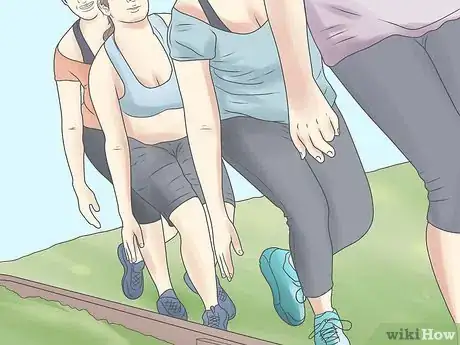wikiHow is a “wiki,” similar to Wikipedia, which means that many of our articles are co-written by multiple authors. To create this article, volunteer authors worked to edit and improve it over time.
This article has been viewed 94,003 times.
Learn more...
A fitness boot camp is a type of physical training class that encourages participants to do cardiovascular and strength training through instructor-led exercises. The classes often include intervals, competitions and team work. It is available through gyms, private trainers and dedicated boot camp businesses. Boot camps may take place inside as well as outdoors. The success of most boot camps is decided based on how they are managed, as well as how the fitness programs are arranged. This article will tell you how to run a fitness boot camp.
Steps
-
1Research the fitness businesses already available in the area. Two important factors of starting any business are knowing your product and knowing your competition. Ideally, you should choose a location that doesn't already offer too many boot camps and has a good supply of active people between the ages of 18 and 50.
-
2Start with good business management. Create a business plan, invest in equipment and create at least a 5-year plan for your business. If you do not have any experience running a business, enroll in business management, marketing and bookkeeping courses in advance.Advertisement
-
3Craft your boot camp so that it offers something different or new. This is especially important if there are a number of fitness options already available. Decide what the features of your product will be and how they will benefit your client.
- For example, you should offer low group sizes, personalized help and special classes to cater to age groups or injuries, if there are a large number of boot camp classes at gyms in the area. These features allow clients to burn more calories and avoid injury while feeling better about their workout.
-
4Focus on quality class structure over price. If you offer discounts or packages without a superior class design, you will be unlikely to keep your customers. Most gyms can offer better package prices with boot camps than privately run classes.
- Consider rest periods, set length, class progression and standards of achievement.
-
5Invest in marketing. Share the features and benefits with your area. Come up with a message and call to action and communicate it through flyers, radio ads, television ads, online coupons and service partnerships.
-
6Invest in equipment. You are likely to need yoga mats, small hand weights, jump ropes, suspension ropes, towels and water. These should be included in your original business plan, along with plans to increase equipment when you start to profit.
-
7Start small. You can start your boot camp with a single group and expand as you receive referrals. Many fitness boot camps take place outside in parks. During the winter, you may be able to run it in a collective space or another fitness business for a small fee.
-
8Time your classes properly. You may not need to offer courses all day long. Boot camps are generally offered in the early morning, lunch time and after work to allow people with busy schedules to make it. If you have a lot of stay-at-home mothers and fathers, you can consider offering mid-day classes and day care.
-
9Create a feeling of camaraderie in your group. People become repeat customers to fitness boot camps when they feel supported and encouraged while they get fit. Structure short competitions and team-based tasks that will be positive and never degrading.
-
10Structure your classes like group personal training. Adjust the itinerary for the people and the day. Most customers cannot get this kind of personalized treatment in a gym, so get creative. Do anything to avoid the "one size fits all" approach.
-
11Get to know your clients. Running a good fitness boot camp requires you to be social. You should request information about injuries and ask questions in a friendly way before, during and after class.
-
12Reward your clients for referrals by giving them a discount or free session occasionally. This is an exceptional way to do targeted marketing.
-
13Adjust your business accordingly. Any successful fitness business must adjust schedules, hire instructors and change with the demographics in the area. Review your classes, staff, equipment and client feedback monthly, quarterly and yearly.
Things You'll Need
- Fitness market research
- Business plan
- Start-up capital
- Business classes
- Marketing materials
- Creative/original class ideas
- Equipment
- Referral bonus
- Staff






























































